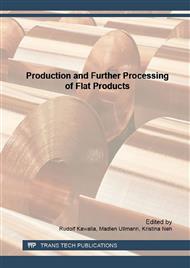p.133
p.140
p.146
p.152
p.158
p.163
p.167
p.174
p.183
Implementation of a Dual Mesh Method for Longitudinal Rolling in QForm V8
Abstract:
Numerical modeling of longitudinal rolling usually requires high computational power meanwhile it still takes long time to simulate multi pass process. Different methods for increasing of accuracy and speed of rolling simulation have being proposed recently. One of them is simultaneous use of two finite element meshes of different density, i.e. dual mesh method. The article is dedicated to solving of important problems of rolling technology and presents several examples of rolling simulation in QForm V8 based on dual mesh method.
Info:
Periodical:
Pages:
158-162
Citation:
Online since:
May 2016
Authors:
Keywords:
Permissions:
Share:
Citation:


